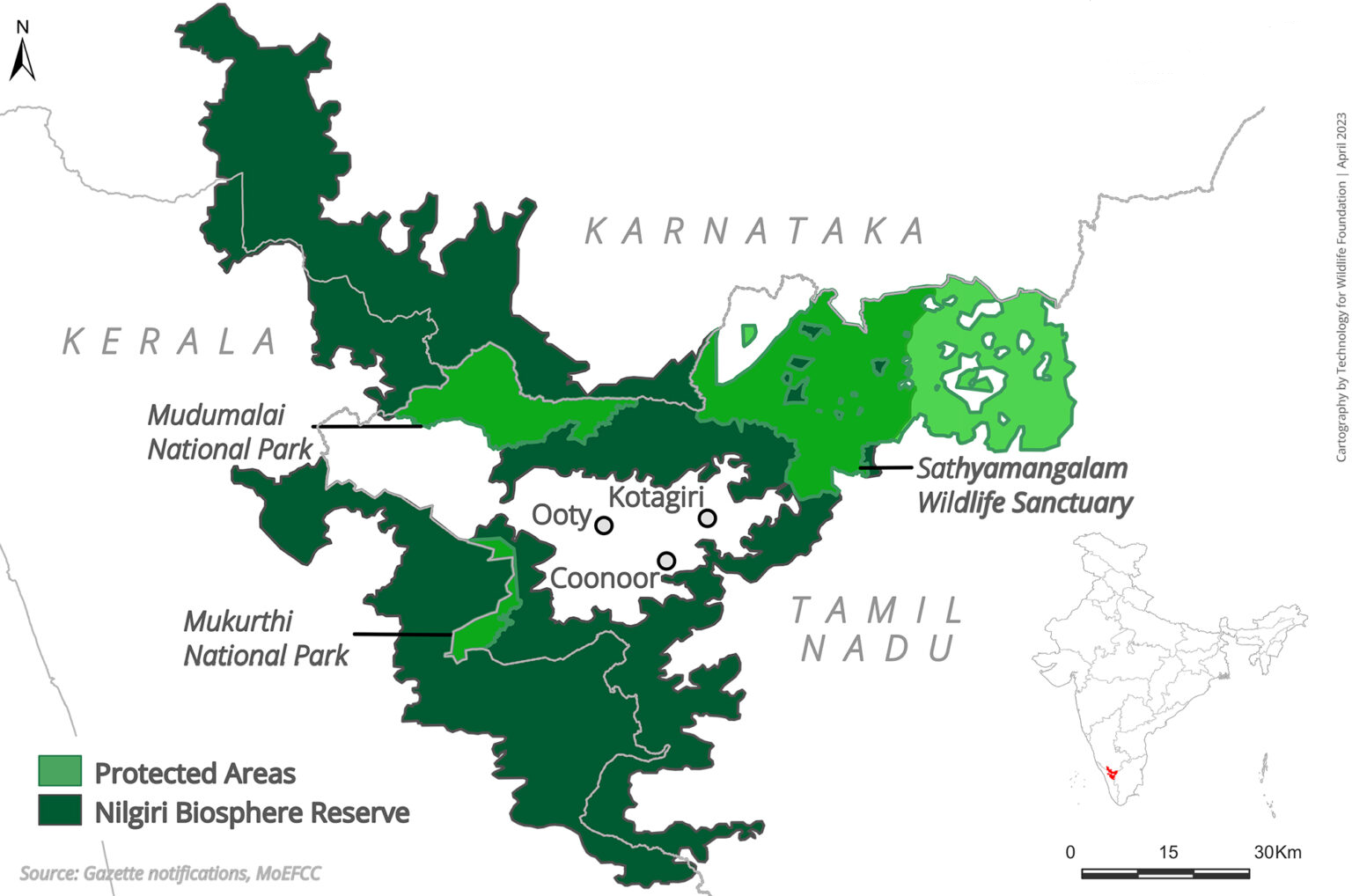Biodiversity & Environment
Tiger Deaths Raise Concerns in Nilgiris Biodiversity
- 04 Oct 2023
- 4 min read
For Prelims: Biosphere Reserve, Nilgiri Biosphere Reserve, Tiger
For Mains: Significance of Tiger Conservation, Related initiatives
Why in News?
The Nilgiris District in Tamil Nadu is home to a rich biodiversity and a large population of tigers. However, in the past two months, 10 tigers have died in the district due to various reasons.
- This has raised concerns among conservationists and officials about the welfare and survival of the big cats.
What are the Reasons for Tiger Deaths in Nilgiris?
- High Density of Tigers:
- The high density of tigers in the Mudumalai-Bandipur-Nagarhole complex of the Nilgiri Biosphere Reserve is pushing populations into the surrounding habitats in the Mukurthi National Park, Nilgiris and Gudalur forest divisions leading to more negative human-animal interactions.
- The rise in tiger numbers puts pressure on prey species like spotted deer, and Indian gaur.
- Scarcity of natural prey could lead tigers to target livestock, exacerbating conflicts and resulting in more deaths.
- Starvation and Infection:
- Tiger cubs, believed to be two weeks old, found dead in the Mudumalai Tiger Reserve's buffer zone.
- Postmortem suggested possible causes as starvation or umbilical infection.
- Tiger cubs, believed to be two weeks old, found dead in the Mudumalai Tiger Reserve's buffer zone.
Why are Conservationists Concerned About Tiger Population Threats?
- Poaching Threat: Recent poaching incidents in the Nilgiris district, underscore the persistent threat to tigers.
- Poachers target tigers for their valuable body parts, such as skins, bones, and organs, posing a grave risk to the population.
- Lack of Tracking and Protection: Concerns arise from the apparent challenges in tracking and protecting tiger populations effectively.
- The inability to monitor and safeguard these majestic animals contributes to conservationists' worries.
- Lack of Prey Management: Inadequate prey population management in protected areas may lead to imbalances.
- Ensuring sufficient prey for tigers is essential for their survival.
- Habitat Degradation: Degraded habitats offer limited resources, forcing tigers to roam in search of food.
- Human activities, deforestation, and encroachments contribute to habitat loss.
Nilgiri Biosphere Reserve
- About:
- The very name Nilgiris’ with literary meaning ‘blue mountains’ has originated from the appearance of blue flower clad mountains (Neelakurinji flowers) of the Nilgiris plateau within the State of Tamil Nadu.
- The reserve spans across three Indian states: Tamil Nadu, Karnataka, and Kerala.
- It was the first biosphere reserve in India established in 1986.
- It is the India’s first biosphere reserve under UNESCO’s Man and the Biosphere Programme.
- Home to several tribal groups such as the Adiyan, Aranadan , Kader , Kurichian , Kuruman , and Kurumbas.
- It portray the confluence of Afro-tropical and Indo-Malayan biotic zones of the world.
- The very name Nilgiris’ with literary meaning ‘blue mountains’ has originated from the appearance of blue flower clad mountains (Neelakurinji flowers) of the Nilgiris plateau within the State of Tamil Nadu.
- Fauna:
- Animals like Nilgiri tahr, Nilgiri langur, slender loris, blackbuck, tiger, gaur, Indian elephant and marten are found here.
- Freshwater fishes such as Nilgiri danio (Devario neilgherriensis), Nilgiri barb (Hypselobarbus dubuis) and Bowany barb (Puntius bovanicus) are endemic to this Biosphere Reserve.
- Protected Areas in NBR:
- The Mudumalai Wildlife Sanctuary, Wayanad Wildlife Sanctuary, Bandipur National Park, Nagarhole National Park, Mukurthi National Park and Silent Valley are the protected areas present within this reserve.
UPSC Civil Services Examination, Previous Year Question (PYQ)
Prelims
Q. Among the following Tiger Reserves, which one has the largest area under “Critical Tiger Habitat”? (2020)
(a) Corbett
(b) Ranthambore
(c) Nagarjunasagar-Srisailam
(d) Sundarbans
Ans: (c)








